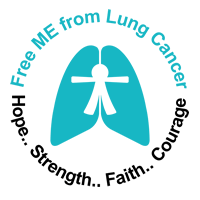 The pathologist checks the sputum, pleural fluid, tissue, or other samples for cancer cells. If cancer is found, the pathologist reports the type.
The pathologist checks the sputum, pleural fluid, tissue, or other samples for cancer cells. If cancer is found, the pathologist reports the type.
The types of lung cancer are treated differently. The most common types are named for how the lung cancer cells look under a microscope:
Small cell lung cancer: About 13 percent of lung cancers are small cell lung cancers. This type tends to spread quickly.
Non-small cell lung cancer: Most lung cancers (about 87 percent) are non-small cell lung cancers. This type spreads more slowly than small cell lung cancer.[1]
Staging: Small Cell/Non-Small Cell: To plan the best treatment, your doctor needs to know the type of lung cancer and the extent (stage) of the disease. Staging is a careful attempt to find out whether the cancer has spread, and if so, to what parts of the body. Lung cancer spreads most often to the lymph nodes, brain, bones, liver, and adrenal glands.
When cancer spreads from its original place to another part of the body, the new tumor has the same kind of cancer cells and the same name as the original cancer. For example, if lung cancer spreads to the liver, the cancer cells in the liver are actually lung cancer cells. The disease is metastatic lung cancer, not liver cancer. For that reason, it’s treated as lung cancer, not liver cancer. Doctors call the new tumor “distant” or metastatic disease.
Stages of Small Cell Lung Cancer
Doctors describe small cell lung cancer using two stages:
Limited stage: Cancer is found only in one lung and its nearby tissues.
Extensive stage: Cancer is found in tissues of the chest outside of the lung in which it began. Or cancer is found in distant organs. The treatment options are different for limited and extensive stage small cell lung cancer. See the Treatment section for information about treatment choices.
Stages of Non-Small Cell Lung Cancer
Doctors describe non-small cell lung cancer based on the size of the lung tumor and whether cancer has spread to the lymph nodes or other tissues:
Occult stage: Lung cancer cells are found in sputum or in a sample of water collected during bronchoscopy, but a tumor cannot be seen in the lung.
Stage 0: Cancer cells are found only in the innermost lining of the lung. The tumor has not grown through this lining. A Stage 0 tumor is also called carcinoma in situ. The tumor is not an invasive cancer.
Stage IA: The lung tumor is an invasive cancer. It has grown through the innermost lining of the lung into deeper lung tissue. The tumor is no more than 3 centimeters across (less than 1 ¼ inches). It is surrounded by normal tissue and the tumor does not invade the bronchus. Cancer cells are not found in nearby lymph nodes.
Stage IB: The tumor is larger or has grown deeper, but cancer cells are not found in nearby lymph nodes. The tumor is more than 3 centimeters across. It has grown into the main bronchus. It has grown through the lung into the pleura.
Stage IIA: The lung tumor is no more than 3 centimeters across. Cancer cells are found in nearby lymph nodes.
Stage IIB: The tumor is one of the following: Cancer cells are not found in nearby lymph nodes, but the tumor has invaded the chest wall, diaphragm, pleura, main bronchus, or tissue that surrounds the heart. Cancer cells are found in nearby lymph nodes, and one of the following: The tumor is more than 3 centimeters across. It has grown into the main bronchus. It has grown through the lung into the pleura.
Stage IIIA: The tumor may be any size. Cancer cells are found in the lymph nodes near the lungs and bronchi, and in the lymph nodes between the lungs but on the same side of the chest as the lung tumor.
Stage IIIB: The tumor may be any size. Cancer cells are found on the opposite side of the chest from the lung tumor or in the neck. The tumor may have invaded nearby organs, such as the heart, esophagus, or trachea. More than one malignant growth may be found within the same lobe of the lung. The doctor may find cancer cells in the pleural fluid.
Stage IV: Malignant growths may be found in more than one lobe of the same lung or in the other lung. Or cancer cells may be found in other parts of the body, such as the brain, adrenal gland, liver, or bone.[1]
